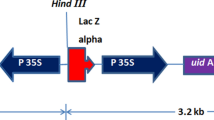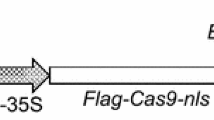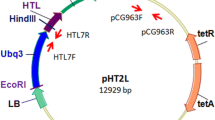Abstract
A reliable and efficient system for transformation and regeneration of 'Chardonnay' (Vitis vinifera L.) plants via microprojectile bombardment was developed. Improvements over the previous biolistic transformation system included: (1) the use of gold particles for bombardment; (2) step-wise selection at 10 then 15 mg/l kanamycin; and (3) embryo induction at 27°C. Embryogenic cell cultures were either bombarded with pBI426, which contains the reporter gene gus (uidA) coding for β-glucuronidase (GUS), or were co-bombarded with pSAN237 carrying the npt-II (neomycin phosphotransferase II) selectable marker gene, and a second plasmid with an antimicrobial peptide gene. A large number of transient (7,883±1,928) and stable (46±32) blue spots per plate at 2 and 95 days after bombardment, respectively, were obtained according to GUS expression analyses. A total of 447 putative transgenic embryos was harvested from 84 bombarded plates. From these embryos, 242 (54%) were regenerated into plants within the first year of the experiment. Southern blot analyses confirmed integration of the transgenes into the grape genome. Co-transformation was tested with four separate antimicrobial constructs. The co-transformation frequency of unlinked genes was 48% as measured by polymerase chain reaction (PCR), and 56% as estimated by dot blot hybridization. Expression of the gus gene, and PCR and Southern blot analyses of npt-II and antimicrobial genes from regenerated plants document stable transformation of 'Chardonnay' and establish the parameters for highly-efficient biolistic transformation in V. vinifera.



Similar content being viewed by others
Abbreviations
- AMP :
-
Antimicrobial peptide
- DBH :
-
Dot blot hybridization
- GM+NOA:
-
Glycerol and maltose liquid medium with β-naphthoxyacetic acid
- gus :
-
β-Glucuronidase gene
- GUS :
-
β-Glucuronidase
- Km :
-
Kanamycin
- Km R :
-
Kanamycin resistant
- mag2 :
-
Magainin-2
- MS :
-
Murashige and Skoog medium
- MS/2 :
-
Half-strength Murashige and Skoog medium
- nos :
-
Nopaline synthase
- npt-II :
-
Neomycin phosphotransferase II gene
- PCR :
-
Polymerase chain reaction
- PGL :
-
Peptidyl-glycine-leucine
- Pubq3 :
-
Arabidopsis ubiquitin-3 promoter
- Pubq10-L :
-
Arabidopsis ubiquitin-10L promoter
- Pubq11 :
-
Arabidopsis ubiquitin-11 promoter
- SP :
-
Signal peptide
- Tnos :
-
Nopaline synthase terminator
- WPM :
-
Woody plant medium
References
Aragao FJL, Barros LMG, Brasileiro ACM, Ribeiro SG, Smith FD, Sanford JC, Faria JC, Rech EL (1996) Inheritance of foreign genes in transgenic bean (Phaseolus vulgaris L.) co-transformed via particle bombardment. Theor Appl Genet 93:142–150
Barcelo P, Hagel C, Becker D, Martin A, Loerz H (1994) Transgenic cereal (Tritordeum) plants obtained at high efficiency by microprojectile bombardment of inflorescence tissue. Plant J 5:583–592
Colby SM, Meredith CP (1990) Kanamycin sensitivity of cultured tissues of Vitis. Plant Cell Rep 9:237–240
Colova-Tsolova V, Perl A, Krastanova S, Tsvetkov I, Atanassov A (2001) Genetically engineered grape for disease and stress tolerance. In: Roubelakis-Angelakis KA (ed) Molecular biology and biotechnology of the grapevine. Kluwer, Dordrecht, pp 441–432
Daley M, Kauf VC, Summerfelt KR, Turner JC (1998) Co-transformation with one Agrobacterium tumefaciens strain containing two binary plasmids as a method for producing marker-free transgenic plants. Plant Cell Rep 17:489–496
Dalton SJ, Bettany AJE, Timms E, Morris P (1999) Co-transformed, diploid Lolium perenne (perennial ryegrass), Lolium multiflorum (Italian ryegrass) and Lolium temulentum (darnel) plants produced by microprojectile bombardment. Plant Cell Rep 18:721–726
DeBlock M, Debrouwer D (1991) Two T-DNAs co-transformed into Brassica napus by a double Agrobacterium tumefaciens infection are mainly integrated at the same locus. Theor Appl Genet 82:257–263
Franks T, He DG, Thomas M (1998) Regeneration of transgenic Vitis vinifera L. Sultana plants: genotypic and phenotypic analysis. Mol Breed 4:321–333
Harst M, Bornhoff BA, Zyprian E, Topfer R (2000) Influence of culture technique and genotype on the efficiency of Agrobacterium-mediated transformation of somatic embryos (Vitis vinifera) and their conversion to transgenic plants. Vitis 39:99–102
Hébert D, Kikkert JR, Smith FD, Reisch BI (1993) Optimization of biolistic transformation of embryogenic grape cell suspensions. Plant Cell Rep 12:585–589
Iocco P, Franks T, Thomas MR (2001) Genetic transformation of major wine grape cultivars of Vitis vinifera L. Transgenic Res 10:105–112
Jayasankar S, Gray DJ, Litz RE (1999) High-efficiency somatic embryogenesis and plant regeneration from suspension cultures of grapevine. Plant Cell Rep 18:533–537
Kikkert JR (1993) The biolistic PDS-1000/He device. Plant Cell Tissue Organ Cult 33:221–226
Kikkert JR (1998) Biolistic transformation of plant cells. In: Celis JE (ed) Cell biology: a laboratory handbook, vol 4. Academic, San Diego, pp 157–161
Kikkert JR, Hébert-Soulé D, Wallace PG, Striem MJ, Reisch BI (1996) Transgenic plantlets of 'Chancellor' grapevine (Vitis sp.) from biolistic transformation of embryogenic cell suspensions. Plant Cell Rep 15:311–316
Kikkert JR, Striem MJ, Martens MH, Wallace PG, Reisch BI (1997) Somatic embryogenesis from anthers and ovaries of six grapevine (Vitis sp.) cultivars. In Vitro Cell Dev Biol Plant 33:314–315
Kikkert JR, Ali GS, Wallace PG, Reustle GM, Reisch BI (2000) Expression of a fungal chitinase in Vitis vinifera L. 'Merlot' and 'Chardonnay' plants produced by biolistic transformation. Acta Hortic 528:297–303
Kikkert JR, Thomas MR, Reisch BI (2001) Grapevine genetic engineering. In: Roubelakis-Angelakis KA (ed) Molecular biology and biotechnology of the grapevine. Kluwer, Dordrecht, pp 393–410
Komari T, Hiei Y, Saito Y, Murai N, Kumashiro T (1996) Vectors carrying two separate T-DNAs for co-transformation of higher plants mediated by Agrobacterium tumefaciens and segregation of transformants free from selection markers. Plant J 10:165–174
Lloyd G, McCown B (1980) Commercially feasible micropropagation of mountain laurel, Kalmia latifolia, by use of shoot-tip culture. Int Plant Prop Soc Proc 30:421–427
Lodhi MA, Ye GN, Weeden NF, Reisch BI (1994) A simple and efficient method for DNA extraction from grapevine cultivars and Vitis species. Plant Mol Biol Rep 12:6–13
Maloy WL, Kari UP (1995) Structure-activity studies on magainins and other host defense peptides. Biopolymers 37:105–122
Martinelli L, Mandolino G (1994) Genetic transformation and regeneration of transgenic plants in grapevine (Vitis rupestris S.). Theor Appl Genet 88:621–628
Mauro MC, Toutain S, Walter B, Pinck L, Otten L, Coutos-Thevenot P, Deloire A, Barbier P (1995) High efficiency regeneration of grapevine plants transformed with the GFLV coat protein gene. Plant Sci 112:97–106
McCabe DE, Swain WF, Martinelli BJ, Christou P (1988) Stable transformation of soybean (Glycine max) by particle acceleration. Biotechnology 6:923–926
McCormac AC, Fowler MR, Chen DF, Elliott MC (2001) Efficient co-transformation of Nicotiana tabacum by two independent T-DNAs, the effect of T-DNA size and implication for genetic separation. Transgenic Res 10:143–155
Murashige T, Skoog F (1962) A revised medium for rapid growth and bio assays with tobacco tissue cultures. Physiol Plant 15:473–497
Nakano M, Hoshino Y, Mii M (1994) Regeneration of transgenic plants of grapevine (Vitis vinifera L.) via Agrobacterium rhizogenes-mediated transformation of embryogenic calli. J Exp Bot 45:649–656
Nandadeva YL, Lupi CG, Meyer CS, Devi PS, Potrykus I, Bilang R (1999) Microprojectile-mediated transient and integrative transformation of rice embryogenic suspension cells: effects of osmotic cell conditioning and of the physical configuration of plasmid DNA. Plant Cell Rep 18:500–504
Norris SR, Meyer SE, Callis J (1993) The intron of Arabidopsis thaliana polyubiquitin genes is conserved in location and is a quantitative determinant of chimeric gene expression. Plant Mol Biol 21:895–906
Perl A, Lotan O, Abu-Abied M, Holland D (1996) Establishment of an Agrobacterium-mediated transformation system for grape (Vitis vinifera L.): the role of antioxidants during grape–Agrobacterium interactions. Nat Biotechnol 14:624–628
Rasco GS, Riley A, Cannell M, Barcelo P, Lazzeri PA (2001) Procedures allowing the transformation of a range of European elite wheat (Triticum aestivum L.) varieties via particle bombardment. J Exp Bot 52:865–874
Sanford JC, Smith FD, Russell JA (1993) Optimizing the biolistic process for different biological applications. Methods Enzymol 217:483–509
Sawant SS, Singh PK, Tuli R (2000) Pretreatment of microprojectiles to improve the delivery of DNA in plant transformation. Biotechniques 29:246–248
Scorza R, Cordts JM, Gray DJ, Gonsalves D, Emershad RI, Ramming DW (1996) Producing transgenic 'Thompson Seedless' grape (Vitis vinifera L.) plants. J Am Soc Hortic Sci 121:616–619
Torregrosa L, Bouquet A (1997) Agrobacterium rhizogenes and A. tumefaciens co-transformation to obtain grapevine hairy roots producing the coat protein of grapevine chrome mosaic nepovirus. Plant Cell Tissue Organ Cult 49:53–62
Torregrosa L, Iocco P, Thomas MR (2002a) Influence of Agrobacterium strain, culture medium, and cultivar on the transformation efficiency of Vitis vinifera L. Am J Enol Vitic 53:183–190
Torregrosa L, Verriés C, Tesniére C (2002b) Grapevine (Vitis vinifera L.) promoter analysis by biolistic-mediated transient transformation of cell suspension. Vitis 41:27–32
Vidal JR, Delavault P, Coarer M, Defontaine A (2000) Design of grapevine (Vitis vinifera L.) cultivar-specific SCAR primers for PCR fingerprinting. Theor Appl Genet 101:1194–1201
Yamamoto T, Iketani H, Ieki H, Nishizawa Y, Notsuka K, Hibi T, Hayashi T, Matsuta N (2000) Transgenic grapevine plants expressing a rice chitinase with enhanced resistance to fungal pathogens. Plant Cell Rep 19:639–646
Zhong H, Sun B, Warkentin D, Zhang SB, Wu R, Wu TY, Sticklen MB (1996) The competence of maize shoot meristems for integrative transformation and inherited expression of transgenes. Plant Physiol 110:1097–1107
Acknowledgements
The authors are grateful to Dr. J. Sanford of FMS Foundation and Dr. F. Smith of Sanford Scientific Inc. for the magainin and PGL constructs. Drs. R. Seem and D. Gadoury suggested the use of these constructs. We thank Drs. S. Brown and G. Fermín (Cornell University) for critically reviewing this manuscript and for helpful discussions. This research was supported by Research Grant No. US-2759–96 from BARD, The United States-Israel Binational Agricultural Research and Development Fund, as well as grants from the Cornell Biotechnology Program, the USDA-Viticulture Consortium-East and the Kaplan Fund. J.R. Vidal was supported by a postdoctoral grant from the Spanish Ministry of Education and Science.
Author information
Authors and Affiliations
Corresponding author
Additional information
Communicated by E.D. Earle
Rights and permissions
About this article
Cite this article
Vidal, J.R., Kikkert, J.R., Wallace, P.G. et al. High-efficiency biolistic co-transformation and regeneration of 'Chardonnay' (Vitis vinifera L.) containing npt-II and antimicrobial peptide genes. Plant Cell Rep 22, 252–260 (2003). https://doi.org/10.1007/s00299-003-0682-x
Received:
Revised:
Accepted:
Published:
Issue Date:
DOI: https://doi.org/10.1007/s00299-003-0682-x




